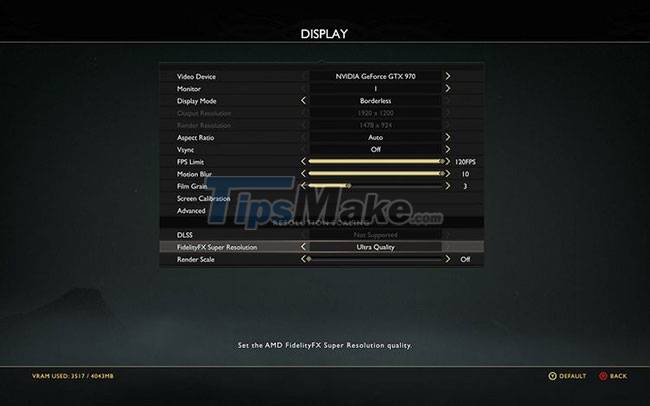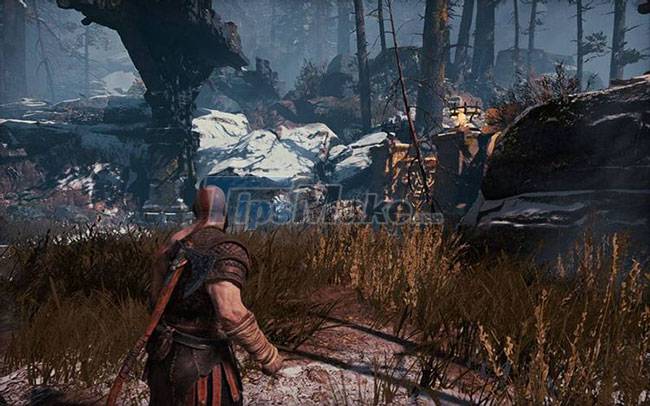What is AMD's FSR? What does the FSR do?
But things have changed, AMD has finally released its own upgrade plan, FSR, and it is taking the gaming world by storm.
What is AMD FSR?
Short for FidelityFX Super Resolution, FSR is AMD's response to NVIDIA's DLSS. TipsMake.com has mentioned how NVIDIA's DLSS works before. And just like NVIDIA's DLSS, AMD's FSR can make games look better and run smoother.
Again, the article says 'maybe', not 'definitely will'. In many cases, FSR won't make your game run smoother or look better. That's why you should know about what FSR can do and how it works before activating the feature.
What can AMD FSR do?
FSR is an innovative reimplementation of shader filtering and upscaling techniques common in emulators. Unlike DLSS, which analyzes game motion, FSR is a combination of:
- A spatial upscaling algorithm takes individual frames to be displayed at a lower resolution and upscales them to the screen's native frame.
- The "intelligent" sharpening shader engine detects and enhances detail for improved clarity.
 FSR is a combination of upscaling techniques and smart shader filters
FSR is a combination of upscaling techniques and smart shader filters
FSR offers 4 quality modes in its current form, displaying game graphics in miniature resolution. The lower the mode, the less detailed and blurry the image produced, with more visible artifacts.
- Ultra Quality reduces the original resolution by 1.3 times.
- Quality reduces the original resolution by 1.5 times.
- Balanced reduces the original resolution by 1.7 times.
- Performance renders graphics at half the original resolution (2x reduction).
Note that the scale factor refers to both horizontal and vertical dimensions. Extremely high quality on a 1920 x 1200 display displayed at a resolution of 1478 x 924, there seems to be no significant reduction, but in fact the number of pixels in the original resolution has been nearly halved:
- 1920 x 1200 = 2304000 pixels
- 1478 x 924 = 1365672 pixels

No upscaling tool can magically recreate those missing pixels. However, that's where the FSR's sharpening shader can help. AMD calls it Contrast Aware Sharpening (CAS). The best way to understand how it works is to visualize the process.
Think of a sketch done with a pencil, then ink on it. The ink does not affect the paper around the pencil lines and the previously thin pencil lines are now more vivid.
So, even though the upscaled images initially have less detail, the FSR engine "makes them sharper". The difference is that the FSR does it dozens of times per second.
However, the FSR may be useless to you. If games run fine at their maximum settings on PC, i.e. at your monitor's native resolution and frame rate, then you simply don't need to use FSR.
By releasing FSR as open source, AMD has ensured its success. Any developer can use it in the game for free.
FSR can also support more affordable GPUs that can't run the latest titles at their native resolutions and highest settings. And that's how a mid-range laptop should be able to render many demanding games at over 60FPS with acceptable graphics settings.
You should read it
- What is 16K resolution?
- Super giant photo taking a panoramic view of Shanghai city, the highest resolution in Asia, zooming in the face of pedestrians
- 8K has not 'covered' Sony has launched a 16K-sized bus screen
- Download video clips on YouTube in super sharp format
- How is the process of capturing billions of Pixel photos?
- What is 4K resolution?
- Photo of the world's highest resolution screen iMac
- Smartphone with up to 48MP resolution camera will be released next year thanks to new image sensor technology
- What is a super app?
- How to download Marvel Super War for iOS and Android
- Microsoft testing low-resolution video upscaling with AI on Edge browser
- Sharp produces ultra-high resolution IGZO screens for laptops






 Can Pokemon Go be played on a computer? The answer is yes!
Can Pokemon Go be played on a computer? The answer is yes! Summary - How to play Pokemon GO, virtual reality game catch Pokemon on smartphone
Summary - How to play Pokemon GO, virtual reality game catch Pokemon on smartphone Things you didn't know about 26 types of Pokeball - Part 2
Things you didn't know about 26 types of Pokeball - Part 2 Stardust's effective way in Pokemon GO
Stardust's effective way in Pokemon GO AZ word about eggs in Pokemon Go
AZ word about eggs in Pokemon Go Things you didn't know about 26 types of Pokéball - Part 1
Things you didn't know about 26 types of Pokéball - Part 1